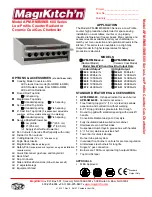
7
INITIAL ACTIVATION AND MAINTENANCE
50
7
INITIAL ACTIVATION AND MAINTENANCE
In this section you will find the following information:
▶
Indications required by the authorized Robur Technical Assistance Centre (TAC) in order to carry out the entire procedure of first
start-up of the appliance (see Paragraph 7.1
→
50);
▶
Indications regarding maintenance operations of the appliance (Paragraph 7.2
→
53): general information and warnings; general
indications regarding checks, controls and cleaning.
▶
Instruction for the Robur TAC or gas type conversion (Paragraph 7.3
→
54).
Before proceeding with the operations described in this section, the installation technician concerned is invited to read
Paragraph 3.1
→
7. in regard to switching the appliance on and off, refer to Paragraph 4.1
→
13. If the appliance is connected
to a DDC (and the DDC is in controller mode), for the phases of activation and deactivation of the appliance it is necessary to
refer to the two manuals dedicated to the DDC itself.
7�1
PROCEDURE FOR FIRST START UP
The initial activation procedure is composed of the following (main) steps.
Step 1: preliminary verification of plant compliance.
Step 2: verification/regulation of combustion parameters and first ignition.
Step 3: regulation of plant operating parameters.
The entire procedure for the initial activation of the appliance must only carried out by an authorised Robur Technical As-
sistance Centre (TAC). The product's guarantee may be void if the procedure is not carried out by a Robur TAC.
Before leaving the factory, the appliance has been thoroughly tested.
Step 1: preliminary verification of plant compliance
The Robur TAC technician must:
▶
Check that the whole installation has been realized in accordance with its design, following the manufacturer's instructions and
respecting current legislation. The design must have been drawn up by a professional specifier.
▶
Check personally that all of the connections (hydraulic/gas and electrical) of the appliance (and of the Direct Digital Controller, if
connected to the appliance) have been made correctly.
▶
Check that the installation is actually compliant as per the Declaration of Conformity provided by the installer to the owner.
The Declaration of Conformity CERTIFIES that the installation is compliant with current regulations. This Declaration is a
mandatory document and as such it must be provided by the installer to the owner.
▶
Check that the water pressure and flow in the hydraulic circuit and the static gas supply network pressure are correct, as indi-
cated by the manufacturer.
▶
Check that the electrical power supply is 230V 50Hz
▶
Check that the air/fumes pipes are properly connected.
▶
Check that the fumes condensate discharge is properly installed.
▶
Check that the safety clearances have been observed, as shown in Figure 5.1
→
19.
If all the conditions listed above exist, the TAC can proceed with the operations, performing the "initial activation" of the appliance.
If any non-compliant elements arise during the initial verification, the TAC may choose not to proceed with the operation of "initial
activation".
In this case, the Robur TAC technician must:
▶
Report the user/installer of any installation anomaly.
▶
Report the user/installer of any situation that is potentially hazardous for the appliance and for people.
▶
Report of any missing documentation relevant to the installation.
▶
According to the reports made, advise any corrective action to be taken at the installer's care in order to proceed with the "first
start up".
It is the responsibility of the user/installation technician to carry out any corrective measures on the plant indicated by the
TAC. Following such corrective measures performed by the installation technician, the TAC will assess the plant again. At
this point, if, in the opinion of the TAC, safety and compliance conditions exist, the TAC must carry out the "initial activation".
Plant situations that are hazardous for people and for the appliance. If one of the following hazardous situations arises, the
TAC must not carry out the "initial activation":
▶
appliance installed in improper configuration (e.g.: type B in closed and insufficiently ventilated area);
▶
appliance installed close to combustible substances or surfaces or in any case in conditions of bad accessibility or not allowing
safe maintenance operations;















































